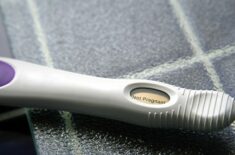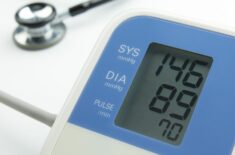Overview
Did you know that your baby’s cord blood is rich in stem cells that may be used as therapy in some cancers (such as leukemia), immune system disorders, and blood diseases (such as anemia)?
While you might not see the need to store your baby’s cord blood now, research shows that cord blood banking may be important for potential future transplants if your baby is found to have certain blood cancers and disorders. (1)
Cord blood banking can help preserve potentially life-saving stem cells, but it can also be costly. So, should you get this for your baby?
Continue reading to learn more.
What’s Cord Blood & Why Is It Important?
Your baby’s umbilical cord connects your unborn baby to the placenta, providing oxygen and nutrients for proper growth and development.
Inside this cord flows blood that contains a high concentration of HSCs (hematopoietic stem cells), estimated to be 10 times the concentration in the bone marrow.
In addition, these stem cells are only half as likely to be rejected during therapy compared with adult stem cells, and they rarely carry any infectious diseases.
In the past, the umbilical cord was usually discarded after birth. However, nowadays, many parents choose cord blood collection and banking to store potentially life-saving stem cells for future use.
Using Cord Blood To Treat Diseases
Umbilical cord fluid may be used as therapy for these conditions: (2)
Cancers
- Different forms of leukemia (cancer in blood-forming tissues that happens when bone marrow cells develop mutation or changes in the genetic material)
- Myelodysplastic syndrome (blood cells in the bone marrow do not mature)
- Neuroblastoma (cancer that develops from immature nerve cells)
- Hodgkin’s disease (mutated cells in the lymphatic system multiply rapidly, causing a large number of abnormal cells in the body)
- Non–Hodgkin’s lymphoma (cancer that starts in lymphocytes, a type of white blood cells)
- Burkitt’s lymphoma (cancer that starts in immune system cells called B-cells)
Blood Or Immune System Disorders
- Sickle cell anemia or sickle cell disease (the patient’s red blood cells are shaped like a sickle instead of being round)
- Fanconi’s anemia (bone marrow that doesn’t produce enough new blood cells)
- Thalassemia (a hereditary blood disorder that causes the body to make abnormal forms or inadequate amounts of hemoglobin)
- Evan’s syndrome (the immune system destroys the body’s blood cells)
- Congenital cytopenia (body has a severely low number of megakaryocytes, bone marrow cells that makes platelets)
- Aplastic anemia (the body stops producing new blood cells)
- Diamond–Blackfan anemia (bone marrow problems cause low red blood cell count; physical symptoms such as cleft palate, webbed neck, and small head size called microcephaly)
- Amegakaryocytic thrombocytopenia (bone marrow failure due to lack of megakaryocytes, the cells that make platelets)
Congenital Metabolic Disorders
- Adrenoleukodystrophy (damaged myelin sheath, the membrane that insulates nerve cells in the brain)
- Gunther’s disease (deficiency in an enzyme called uroporphyrinogen cosynthetase affects the heme, a substance needed by the body to bind oxygen to the blood)
- Gaucher’s disease (an enzyme called glucocerebrosidase causes the body to accumulate harmful quantities of fats called glycolipid glucocerebroside in the liver, bone marrow, and spleen)
- Hurler’s syndrome (complete deficiency in an enzyme called alpha-L-iduronidase causes enlarged liver and spleen, heart disease, respiratory problems, and reduced life expectancy)
- Hunter’s syndrome (the body doesn’t properly digest sugar molecules, causing harmful build-up inside organs and tissues)
- Krabbe’s disease (damaged myelin, the protective coating of nerve cells in the brain)
- Sanfilippo’s syndrome (abnormal build-up of large sugar molecules called GAGs or glycosaminoglycans in lysosomes, cells that contain enzymes)
- Tay-Sachs’ disease (the absence of an enzyme called hexosaminidase A causes excessive accumulation of fats called gangliosides in nerve cells and the brain)
Immunodeficiencies
- Adenosine deaminase deficiency (gene mutations cause deficiency in an enzyme called adenosine deaminase and lead to low concentrations of white blood cells called lymphocytes that protect the body from infections)
- Wiskott-Aldrich’s syndrome (decrease in the number and size of platelets, blood cells needed for clotting)
- Duncan’s disease (the body only produces low levels of white blood cells called CD27 memory B cells, leading to bone marrow failure)
- Ataxia-telangiectasia (gene mutations cause mental development and ataxia or decreased movement coordination)
- DiGeorge’s syndrome (deletion of chromosome 22 causes delayed mental development, kidney problems, congenital heart problems, hearing loss, and frequent infections)
- Myelokathexis (white blood cells called neutrophils are retained in the bone marrow and are unable to fight infections)
- Hypogammaglobulinemia (deficiency in antibodies called gamma globulins causes a higher risk of infection)
- Severe combined immunodeficiency (SCID; genetic mutations cause defective immune system response, leading to severe response against any form of bacterial, fungal, or viral infections such as the coronavirus disease)
Clinical trials show that stem cell therapies may also be used for: (3)
- Spinal cord injuries
- Type 1 diabetes
- Parkinson’s disease
- ALS (amyotrophic lateral sclerosis)
- MS (multiple sclerosis), the immune system attacks nerve fibers’ protective covering, which could lead to serious brain and spinal cord problems
- Sjögren’s syndrome (an autoimmune disease that causes dry mouth and eyes)
- Alzheimer’s disease
- Heart disease
- Stroke
- Burns
- Osteoarthritis
- Eye disorders
- Regeneration of dental tissues
- Regeneration of jaw bone tissues
Studies are also being done for the possible future use of stem cells as therapy for these conditions:
- ASD (autism spectrum disorder; it’s a complicated condition that may affect behavior and communication)
- Cerebral palsy (brain damage during development causes problems in muscle control and coordination, speech delay, and possible cognitive impairment)
- Lupus (the immune system attacks tissues and organs in the body)
FDA-Approved Cellular And Gene Therapy Products
The FDA (Food and Drug Administration) warns the public about the potential effects of falsely advertised or fake stem cell products because these unproven stem cell therapies can be unsafe for use.
Unproven treatments could cause:
- Growth of tumors
- Reaction at the administration site
- Failure to work as advertised or expected
- Mutations in stem cells that may lead to replication of wrong cell types
The following are FDA-approved cellular and gene therapy products under the OTAT (Office of Tissues and Advanced Therapies): (4)
- ABECMA by Celgene Corporation, a Bristol-Myers Squibb Company
- ALLOCORD by SSM Cardinal Glennon Children’s Medical Center
- BREYANZI by Juno Therapeutics, Inc., a Bristol-Myers Squibb Company
- CLEVECORD by Cleveland Cord Blood Center
- Ducord by Duke University School of Medicine
- GINTUIT by Organogenesis Incorporated
- HEMACORD by New York Blood Center
- HPC, Cord Blood by Clinimmune Labs, University of Colorado Cord Blood Bank
- HPC, Cord Blood – MD Anderson Cord Blood Bank by MD Anderson Cord Blood Bank
- HPC, Cord Blood – LifeSouth by LifeSouth Community Blood Centers, Inc.
- HPC, Cord Blood – Bloodworks by Bloodworks
- IMLYGIC by BioVex, Inc., a subsidiary of Amgen Inc.
- KYMRIAH by Novartis Pharmaceuticals Corporation
- LAVIV by Fibrocall Technologies
- LUXTURNA by Spark Therapeutics, Inc.
- MACI by Vericel Corp.
- PROVENGE by Dendreon Corp.
- TECARTUS by Kite Pharma, Inc.
- YESCARTA by Kite Pharma, Incorporated
- ZOLGENSMA by AveXis, Inc.
Alternatives To Cord Blood Banking
Bone Marrow Sources
This type of transplant replaces damaged bone marrow due to infection, disease, or chemotherapy.
This medical procedure has been used since the first successful stem cell therapy in 1956 involving a patient with leukemia who received bone marrow stem cells from his identical twin. (5)
But bone marrow collection is invasive and considerably more expensive ($1,641 to $4,471) than cord blood collection ($1,000 to $2,000).
Embryonic Stem Cells
Studies are being performed using stem cells from embryos (babies in the earliest stages of pregnancy). But this is highly controversial due to ethical concerns in extracting these biological samples from human babies.
According to the guidelines by the NIH (National Institutes of Health), embryonic stem cells can only be collected from embryos created by in vitro fertilization when the embryo is no longer needed. But this still requires informed consent from the woman from whom the egg samples were harvested.
Cord Blood Vs. Bone Marrow Stem Cells
Advantages
Using umbilical cord blood stem cells has several advantages over bone marrow stem cells:
- Cord blood is easy to collect. The process won’t even hurt or affect your baby.
- The collection process is less expensive than getting bone marrow grafts.
- Less risk for transmission of infection
- Less need for stringent antigen typing
- Less risk of rejection
Disadvantages
These are the disadvantages of using umbilical cord blood stem cells vs. bone marrow: (2)
- Slow engraftment (although the stem cells aren’t rejected, recovery could be longer because the donor stem cells might not start working immediately)
- Limited cell dose (only a small volume is available, and you can’t get additional cell doses if needed)
- Autologous donations may have limited benefit because of hereditary disorders already present in the cord blood
- Storage issues (high costs, unknown length of long-term storage, and quality control problems)
Controversies & Ethical Considerations
False Advertisement Issues
Professional organizations, especially the AAP, warn parents against the false advertising tactics used by private companies to entice them to pay the hefty fees for the private storage of cord blood.
The AAP warns that many of these private companies’ statements are outright misleading and inaccurate. (2)
Legal And Informed Consent Issues
Once considered to be just a waste product after birth, cord blood now has value. It’s also considered a biological product that’s part of the baby until it is removed from the body.
So, informed consent should be obtained before collection.
Often, the mother’s consent is obtained, and the father’s consent might not be necessary. But the cord blood legally belongs to the child, not to any of the parents. So, even with a parent’s consent, this could still be a legal and ethical issue. (2)
Timing Of Clamping Controversy
The timing of when to clamp the umbilical cord may be the biggest controversy because the cord still provides nourishment to the baby and removes waste until it spontaneously stops pulsing or when it is clamped. (2)
That’s why in making a birth plan, some parents choose to clamp the cord only when it stops pulsing.
Cord Blood Banking Options
ACOG (American College of Obstetricians and Gynecologists) neither recommends nor prohibits the routine banking of umbilical cord blood. Instead, they recommend that pregnant women should be given unbiased information about cord blood banking.
Both ACOG and the AAP (American Academy of Pediatrics) recommend this procedure only for families who have an immediate member diagnosed with a condition wherein stem cell transplantation is currently being used as treatment, but not for “potential future use.”
But even then, there’s only a 25% chance that a sibling will be the perfect genetic match. So, a cord blood or bone marrow transplant from an unrelated donor might still be necessary.
Cord blood collected at birth has to be stored immediately. You have three options:
- Private cord blood banking
- Public cord blood banking
- Direct-donation cord blood banking
Pros & Cons Of Private Cord Blood Banking
Pros
If you choose to store your baby’s cord blood at private cord blood banks, only your child or other family members can use this. So, the stock will always be ready for the family.
Cons
Commercial or private cord blood banking companies charge a fee for processing, plus an annual storage fee which could be expensive.
The AMA (American Medical Association), ACOG, and the AAP caution parents about private cord blood banks because:
- The chance that your child will use privately banked cord blood might be extremely low.
- Other available treatments may be less costly.
- Collection and storage costs at these facilities can be high.
- Many claims made by these private facilities may be unfounded, and some might be outright misleading. (2)
Though stem cell therapy has been performed in over 60,000 patients globally in the last two decades, most of these are unrelated donor cord blood transplants.
In contrast, only 400+ autologous cord blood transplants (using the individual’s own cord blood) were performed in the same period.
Autologous transplants might not be possible because the genetic mutations and blood disorders supposedly treated by stem cells might already be present in the baby’s cord blood.
So, umbilical cord blood banking at a private facility might not be cost-effective or worthwhile, considering the price you’ll have to pay and the low possibility that you or your family can use it.
How Much Does It Cost To Bank Cord Blood?
- Fees charged by a healthcare provider (for cord blood collection) can vary
- Cord blood collection fee (includes processing and cryo-preservation) can cost from $1,000 to $2,000.
- Cord blood storage fee can cost around $100 to $200 per year.
Choosing A Cord Blood Bank
Only choose a cord blood bank accredited by the AABB (American Association of Blood Banks). Some of these are:
- ViaCord owned by PerkinElmer, Inc. (collection fee + 1 year: $2,945; annual fees: $175)
- Cord Blood Registry owned by GI Partners (collection fee + 1 year: $2,840; annual fees: $185)
- CryoCell owned by Cryo-Cell International, Inc. (collection fee + 1 year: $3,170; annual fees: $175)
Pros & Cons Of Public Cord Blood Banking
Though the AAP cautions against private cord blood banking, the professional association recommends cord blood collection for all families. But banking should be in public facilities for public use by the general population. (2)
Donations may be made through the National Marrow Donor Program.
Pros
- Cord blood donation to a public cord blood bank is free.
- Because it’s a public facility, all the cord blood that people donate can be used by anyone who needs it.
- This cord blood may also be used for research.
- Cord blood transplant from unrelated donors is more common than autologous transplants (patient receives a transplant of own stem cells).
- There are more than 20 million volunteers under the National Marrow Donor Program. (6)
Cons
- You no longer own the donated cord blood. So, it’s unlikely that your baby or other family members can use this same blood when needed in the future.
- Public facilities don’t pay for the transport of stored cord blood to the hospital for transplant. So, it might cost you more to get stem cells from a public bank if your insurance doesn’t cover it.
Pros & Cons Of Direct-Donation Cord Blood Banking
Pros
- This facility is a combination of private and public cord blood banks.
- Donated cord blood for public use is stored for free.
- Donations reserved for families are also accepted, especially for a baby with a sibling with a disorder or medical condition that may be treated with stem cell therapy.
Cons
- Like in public facilities, it can be costly to transport stored cord blood when needed for transplantation.
Cord Blood Banking FAQs
Is Cord Blood Banking Worth It 2020?
Commercial facilities often market their services as “biological insurance” to protect your child against future diseases.
The chance that your baby will be able to use its own cord blood is very small: from 1:400 to a 1:200,000 chance over your child’s lifetime. Even if your baby might be due for stem cell transplantation, the source will likely be from someone else. (2)
How Is Cord Blood Collected?
If you decide to collect and store or donate your baby’s cord blood stem cells, make sure to put that on your birth plan so your healthcare provider can properly collect the blood.
The collection of cord blood is simple. After birth, your doctor will clamp the umbilical cord in two places, around 10 inches apart, before cutting to separate you from your baby.
Around 40ml to 120ml of umbilical cord blood will be collected from this clamped portion. If you have a banking kit, the fluid will be placed in the blood collection tubes/vials. If you don’t have a kit, the blood will be put in a special bag or tube and sent to the blood bank.
This process is painless for you and your baby. It will take just around 10 minutes or less.
Do All Hospitals Process Cord Blood Collection?
No. Not all hospitals collect cord blood, whether for private or public banking. So, it’s best to verify this with your healthcare provider so you can find another hospital if you plan on storing your baby’s blood.
Can I Delay Cord Clamping?
You can request a DCC (delayed cord clamping) until the umbilical cord stops pulsing for ethical considerations. Pulsing usually stops for an average of 30 seconds to 180 seconds after birth.
Even with DCC, you may still collect and bank your baby’s cord blood. But check with your OB-GYN or medical provider just to be sure.
What Problems Can Affect Cord Blood Collection?
- The amount of collected cord blood will be less if you decide on DCC.
- It’s also possible that not enough blood will be collected if your baby is born prematurely.
- If an emergency happens during delivery, the doctors will prioritize saving you and your baby over cord blood collection. So, no sample might be collected.
How Successful Are Cord Blood Transplants?
The first transplant of this kind was successfully performed in 1988, with the patient receiving cord blood stem cells from a disease-free twin sibling.
Over 35,000 cord blood transplants have been performed worldwide. (7)
How Long Does Cord Blood Banking Last?
Research shows that stored cord blood may only be used for 15 years. After that, it might not be as effective.
Do You Need To Store Cord Blood For A Second Child?
Even if they have the same parents, siblings don’t have the genetic makeup. Often, siblings only share around 50% of the same DNA due to recombinations.
So, if you decide to store cord blood for one child, you might also consider doing the same thing for the second child and subsequent siblings.
What Happens If The Donor Isn’t A Good Match?
Two scenarios could happen:
- Rejection: The immune system attacks the transplanted stem cells.
- Graft-versus-host disease: The donor stem cells attack the body’s cells.
How Is A Stem Cell Transplant Done?
The transplant is done at a hospital and generally follows this procedure:
- Donor matching and tests are done.
- The patient receives radiation treatment and/or chemotherapy. These procedures kill the cells causing the illness and weaken the immune system so it won’t reject the donor stem cells.
- Doctors place a special IV (intravenous) called the central line and connect it to a large vein near the heart.
- The patient receives the donor stem cells through this IV line.
- Afterward, the patient stays for three to five weeks in the hospital for possible blood transfusion, prevention and treatment of possible complications, and monitoring to check if the donor stem cells make new blood cells.
Do Doctors Recommend Cord Blood Banking?
Doctors may have different opinions about cord blood banking. Some doctors don’t recommend it because if your baby might need one someday, there may be a big chance that it must come from someone else’s cord blood. (8)
But storing your baby’s cord blood may help their sibling.
REFERENCES
(1) https://www.ncbi.nlm.nih.gov/pmc/articles/PMC6091883/
(2) https://www.ncbi.nlm.nih.gov/pmc/articles/PMC3209739/
(3) https://www.ncbi.nlm.nih.gov/pmc/articles/PMC7367472/
(4) https://www.fda.gov/vaccines-blood-biologics/cellular-gene-therapy-products/approved-cellular-and-gene-therapy-products
(5) https://www.britannica.com/science/bone-marrow-transplant
(6) https://www.ncbi.nlm.nih.gov/pmc/articles/PMC3952633/
(7) https://wmda.info/cord-blood/basics-cord-blood/
(8) https://www.mottchildren.org/health-library/zx1634












